Designing for Extreme Environments
Sun Control Strategies
As we have noted, natural light can enhance the function of any room with proper sun management. From both an energy efficiency and a resilient design standpoint, finding ways to do that without requiring electricity or other energy is preferred. Further, choosing systems that are fully adjustable allows the best performance for specific times of day or seasons of the year. Among the options available to meet all of these needs, fabric shades are a common choice suitable for both new and existing buildings. Part of their popularity stems from the broad range of shading fabrics that can be used in roller shade applications. They can be selected and specified to operate with electric rollers, manual pull cords, or both.

Images courtesy of Simonton Windows & Doors
The construction of windows suitable for extreme conditions includes extra reinforcing in the frame, weather-resistant profiles, and glazing that includes at least one layer of laminated glass.
Sun control fabrics can be used in the closed position to protect interior spaces from the harmful effects of solar heat and light. In normal conditions, these fabrics reduce solar heat gain that can translate into energy savings related to cooling the building. Depending on the particular fabric selected, they can also enhance the use of natural daylighting, allowing electric lights to be turned off. By reflecting and diffusing solar energy and glare, these fabrics create a more comfortable interior environment whether during times of normal or severe weather conditions. Sun control fabrics also help reduce the fading of interior furnishings and flooring by protecting these surfaces from the harmful effects of ultraviolet (UV) rays. And, unlike many window treatments, open weave sun control fabrics allow excellent outward visibility—even when shades are lowered—to maintain optimal views. PHIFER Incorporated's Strickland sums it up this way: “Sun control fabrics are designed to create cool and comfortable environments while maintaining the beauty and function of glass facades.”
Sun control fabrics can reduce glare from 70 to 100 percent based on color and the openness factor of the fabric. Color and openness factors are the most important features to consider for energy savings and light management. Color options range from lighter whites to darker brown and black colors. Lighter color fabrics provide optimum heat reduction, reflecting light and illuminating the interior. Darker fabrics provide a superb view to the outside and absorb light to reduce glare, making them ideal for viewing computer and television screens. The openness of a fabric refers to the weave or mesh structure and determines the amount of heat and light that enters a room. Generally, a more open fabric allows more heat and light to penetrate through while tighter meshes block more heat and light. Additionally, more open fabrics help maintain better outward visibility. Sun control fabrics are offered in a variety of openness factors to allow optimal light in commercial buildings or provide more privacy for such applications as hospitals and healthcare applications.
Many sun control fabrics are engineered to include the latest in technology and performance features, making them the fabric of choice for the most demanding environments. Suitable for residential, office, business, hospitality, healthcare, education, government, and retail buildings, shading fabrics are available that are very durable and easy to maintain. It is even possible to specify that bio-based plasticizers be used in the shades which offer a renewable and more sustainable alternative to traditional petroleum based plasticizers. The immediate inherent benefits of such a product include lower embodied energy and reduced greenhouse gas emissions—as much as 40 percent lower when compared to PVC compounds. As a bio-based product, it can qualify as a rapidly renewable material. It is also phthalate-free contributing to healthier indoor environmental quality. All of that helps it contribute to earning credits in the U.S. Green Building Council's LEED® rating system. These results can be achieved while still maintaining all of the established benefits of vinyl sun control fabrics such as durability, clean-ability, and fabric longevity.
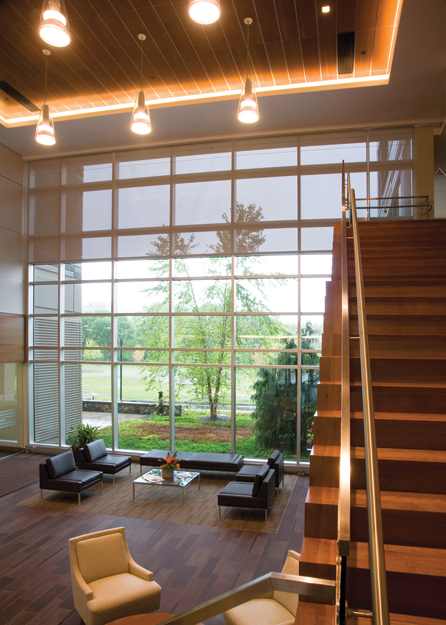
Photo courtesy of Springs Window Fashions, Middleton, Wisconsin, and PHIFER Incorporated
Incorporating sun screens into glazed areas helps to control heat gain into a space while maintaining views to the exterior.
Thermal Resistance Strategies
Successful thermal control strategies start with effective building insulation. For walls, and roofs that means it needs to be a continuous insulation system as recognized by recent energy code provisions and it needs to be compatible with the rest of the building construction. In that regard, it is not surprising that closed cell, rigid foam, polyisocyanurate (aka polyiso) insulation is used in over 70 percent of commercial low-slope roof construction, in a substantial portion of commercial sidewall construction, and in residential construction.
Inch for inch, polyiso has the greatest energy efficiency performance or R-value of any rigid foam insulation product on the market. Because of its higher R-value per inch, less polyiso material is required in a wall or roof assembly compared to other insulation types. The results include greater energy efficiency, reduced energy waste, and lowered costs for both materials and labor. From a design standpoint it also means thinner walls and roofs with shorter fasteners.
In terms of resiliency, roof systems need to be able to resist wind forces that can lead to literally tearing the roof off of a building. This ability is not just limited to the roofing membrane but to the whole assembly of the roofing system above the structural roof deck. Factory Mutual (FM) Approvals is a nationally recognized testing laboratory that tests and certifies building materials, fire protection equipment, and electrical equipment in order to help prevent or reduce property damage. The designation of a “Class 1” roof rating by Factory Mutual indicates a roof which meets the criteria for fire, wind, foot traffic, and hail damage resistance based on the successful testing of the whole roof assembly using the FM 4470 test standard. Polyiso has successfully and routinely been tested and used to meet the requirements to be included in an FM Class 1 roofing system.
Maintaining the integrity of the roof system is important in all conditions, but in severe weather events, it is more significant since a breach of the roofing can quickly lead to deterioration and damage of the rest of the building. Even if roofing damage is not severe, it still needs to be intact in order to maintain thermal integrity. Polyiso insulation brings the characteristics of dimensional stability, excellent compressive strength, moisture resistance, and long service life to a building, all of which will help maintain the integrity of the system over time and during a severe event.
Building codes have a good bit to say about the use of foam plastic insulation, primarily in the area of fire test performance. Of all of the foam insulation boards available, polyiso performs exceptionally well in meeting these code requirements. For walls, polyiso achieves a Class A or Class B rating under ASTM E84; foil-faced polyiso passes NFPA 285 without additional fire stopping materials and is approved for many cladding options. It is also the only high-performance thermal foam insulation to pass both the ANSI UL 1256 and FM 4450 fire tests without a thermal barrier. None of this should really be too surprising since polyiso insulation was originally designed for NASA and used for extreme conditions. At a more down-to-earth level, though, the combination of good fire ratings and wind/tear off performance means that it often receives preferred insurance ratings for building owners.
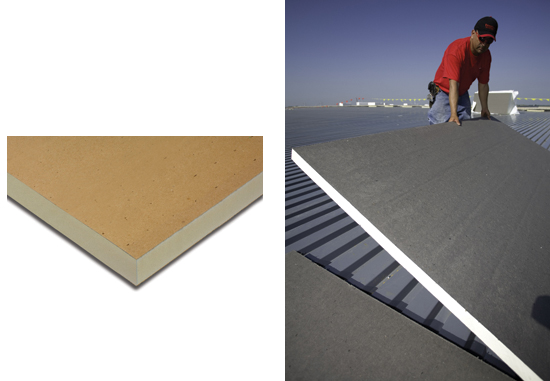
Images courtesy of Johns Manville (left) and Firestone Building Products (right)
Polyisocyanurate insulation boards provide high R-value thermal resistance in roof and wall construction in a variety of building types.
From a sustainability standpoint, PIMA has developed a third-party-verified ISO-compliant Environmental Product Declaration (EPD) for polyiso roof and wall insulations for use by PIMA manufacturing members across North America. An EPD is an internationally recognized and standardized tool that reports the environmental impacts of products, and EPDs have become increasingly important tools for determining the true sustainability of a product. PIMA's EPDs document that the energy savings potential of polyiso roof and wall insulation over a typical 60-year building life span is equal to up to 47 times the initial energy required to produce, transport, install, maintain, and eventually remove and dispose of the insulation. In addition to a high return on embodied energy, the EPDs document that polyiso roof and wall insulation offer high unit R-value per inch, zero ozone depletion potential, recycled content, opportunity for reuse, and outstanding fire performance.
Polyiso is made using an EPA-compliant hydrocarbon-based blowing agent which has zero Ozone Depletion Potential (ODP) and virtually no Global Warming Potential (GWP). As such, polyiso insulation has been cited by the U.S. Environmental Protection Agency for its responsible impact on the environment. Polysio products have also received many environmental awards. These include an honorable mention in the Sustainable Buildings Industry Council's (SBIC) – “Best Practice” Sustainability Awards Program and the U.S. EPA's Climate Protection Award for the association's leadership in promoting energy efficiency and climate protection.
Flood Vents
One of the most damaging concerns during a flood is not just water damage to a building or its contents, but structural failure. This can happen when water builds up on the outside of foundation walls or walls of enclosure. In flood conditions like this, hydrostatic pressures can be extreme and can shift, separate, and even destroy foundations if they are not properly floodproofed. As a result, the NFIP Regulations and Building Codes require that any residential building constructed in Flood Zone Type A have the lowest floor, including basements, elevated to or above the Base Flood Elevation (BFE). Enclosed areas are permitted under elevated buildings provided that they meet certain use restrictions and construction requirements such as the installation of self-operating flood vents to allow for the automatic entry and exit of flood waters. This accepted mitigation technique is referred to as wet floodproofing and is required for residential buildings in a flood zone. Commercial buildings have the option to wet floodproof, which can be more cost-effective compared to dry floodproofing.
Flood vents are manufactured products that are sized to match standard masonry block sizes. They can be installed in normal block coursing, in a concrete wall, or in framed construction. They consist of a vented or insulated (as desired) horizontal swinging “door” that is designed to stay closed under normal conditions and rotate open during a flood. Typically the flood vent door is latched closed until floodwater enters. Rising floodwater lifts internal floats, which unlatch and open the door. Water flows through the open vent door with flood debris also allowed to pass through without blocking the opening. Note that this is quite different from typical air vents that will clog with flood debris and are not designed to be used in flood scenarios.
It is possible to specify dual-function flood vents to be used for a home with a crawlspace or any enclosed area that requires both natural air ventilation and flood protection. In one product, a bimetal coil automatically opens and closes the ventilation louvers as temperature changes, meaning no electricity is required. The louvers will be fully closed at 35 degrees F and fully open at 75 degrees F. In the event of a flood the internal floats lift to release the flood door to rotate open and relieve the hydrostatic pressure regardless of the louvers' position, open or closed.
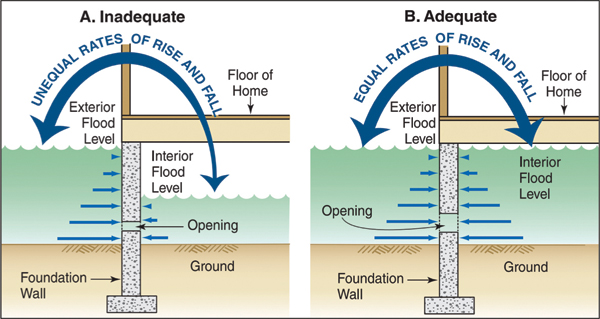
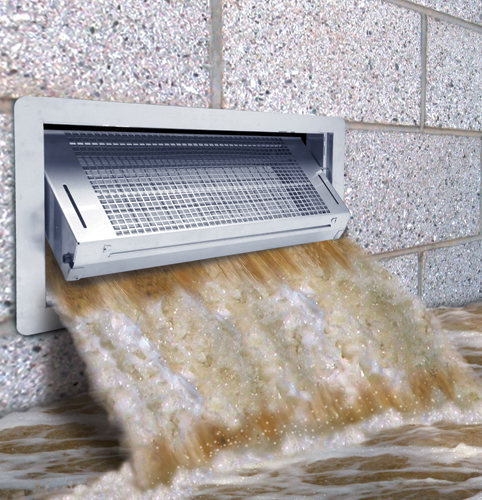
Images courtesy of Smart Vent Products, Inc.
Flood vents protect the construction of a grade level wall by allowing water pressure from flooding to be equalized on either side of the wall, thus preventing damage or collapse.
Insulated flood vents are used for a garage or conditioned space where flood protection is required but air ventilation is not desired. For situations where a sealed crawlspace is being utilized in a floodplain, flood protection is still required and insulated flood vents work quite well for those applications. In this case, the flood door contains a styrofoam core with a designated R-value. There may also be a felt weather stripping that lines the entire vent frame, helping to keep the enclosure as thermally efficient as possible.
With luck, most of the buildings built to NFIP standards will never face a catastrophic flood, but effective floodproofing measures also result in more durable structures that require less maintenance and suffer an estimated 80 percent less damage every year. If the worst case does occur, the right floodproofing option will increase a building's “sustainability” in a fundamental way, often determining whether or not the building will survive at all. Smart Vent Products' Shaw says, “A house is only as strong as the flood vents protecting it. Flood vents are utilized because it's a building code requirement in flood zones and a requirement to obtain a compliant NFIP flood insurance rating, when applicable. Most people tend to forgo the most important reason to utilize proper flood vents, which is the protection they provide. Inadequate flood venting causes unequal rates of water to rise and fall between the inside and outside of the building enclosure, decreasing the ability of the enclosure to withstand exterior pressure. Effective flood venting allows the water to rise and fall equally on both sides of the enclosure thereby equalizing the pressure to help avoid structural damage. In addition, this will reduce the chance that exterior floodwater will rise high enough to reach and enter the first finished floor level.” His years of experience with dealing with flood issues has caused him to promote the importance of this simple but effective measure.
Conclusion
All buildings are facing the likelihood of climate changes and weather events that will impact the short-term performance and long-term sustainability of those buildings. Design professionals who understand and plan for these inevitabilities will be in a position to create buildings that can literally weather the storms. The ability for these buildings to be resilient or bounce back from such events and remain usable starts in the design process in real and meaningful ways as has been shown in this discussion.
Peter J. Arsenault, FAIA, NCARB, LEED AP, is an architect and green building consultant who has authored over 100 continuing education and technical publications as part of a nationwide practice. www.linkedin.com/in/pjaarch
 |
 |
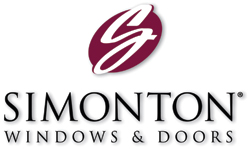 |
 |
Notice

Photo courtesy of Grupo American Classic, Monterrey, Mexico
www.phifer.com

www.polyiso.org

www.Simonton.com
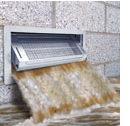
www.smartvent.com









